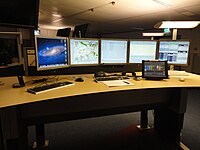
Photo from wikipedia
STUDY OBJECTIVE We compare reported crash rates for US ambulances responding to or transporting patients from a 911 emergency scene with or without lights and sirens. Our null hypothesis is… Click to show full abstract
STUDY OBJECTIVE We compare reported crash rates for US ambulances responding to or transporting patients from a 911 emergency scene with or without lights and sirens. Our null hypothesis is that there will be no difference in the rate of ambulance crashes whether lights and sirens are used. METHODS For this retrospective cohort study, we used the 2016 National EMS Information System data set to identify 911 scene responses and subsequent patient transports by transport-capable emergency medical services (EMS) units. We used the system's "response mode to scene" and "transport mode from scene" fields to determine lights and sirens use. We used the "type of response delay" and "type of transport delay" fields to identify responses and transports that were delayed because of a crash involving the ambulance. We calculated the rate of crash-related delays per 100,000 responses or transports and used multivariable logistic regression with clustered (by agency) standard errors to calculate adjusted odds ratios (AORs) (with 95% confidence intervals [CIs]) for the association between crash-related delays and lights and sirens use for responses and transports separately. RESULTS Among 19 million included 911 scene responses, the response phase crash rate was 4.6 of 100,000 without lights and sirens and 5.4 of 100,000 with lights and sirens (AOR 1.5; 95% CI 1.2 to 1.9). For the transport phase, the crash rate was 7.0 of 100,000 without lights and sirens and 17.1 of 100,000 with lights and sirens (AOR 2.9; 95% CI 2.2 to 3.9). Excluding responses and transports with only partial lights and sirens use did not meaningfully alter the results (response AOR 1.5, 95% CI 1.2 to 1.9; transport AOR 2.8, 95% CI 2.1 to 3.8). CONCLUSION Ambulance use of lights and sirens is associated with increased risk of ambulance crashes. The association is greatest during the transport phase. EMS providers should weigh these risks against any potential time savings associated with lights and sirens use.
Journal Title: Annals of emergency medicine
Year Published: 2018
Link to full text (if available)
Share on Social Media: Sign Up to like & get
recommendations!